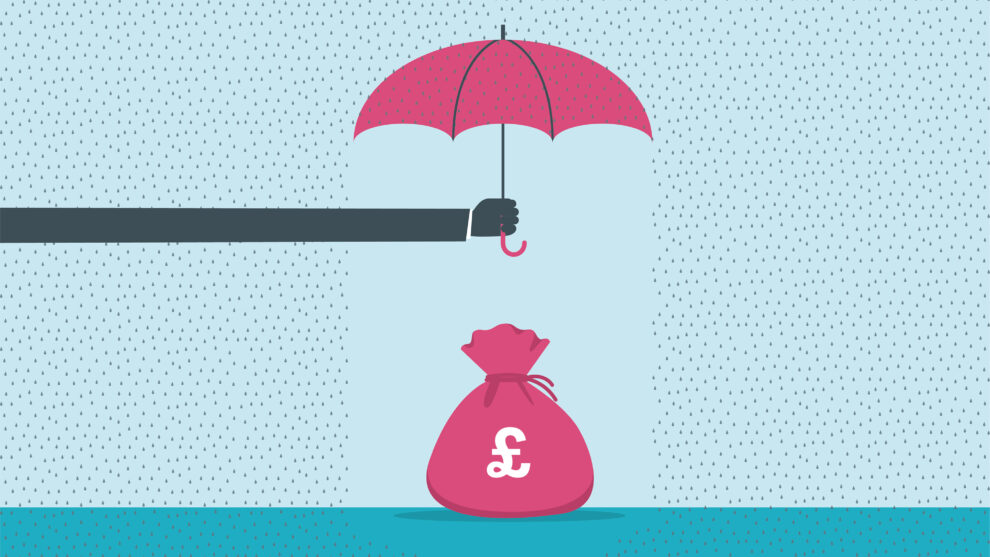In an unpredictable financial world, ensuring the safety of your savings has never been more critical. Economic downturns, inflation, and rising interest rates can all impact the stability of banks and financial institutions, leaving many savers wondering: Is my money genuinely safe?
One key mechanism designed to safeguard your funds is deposit protection. This system guarantees a certain amount of money in your bank account, even if the institution fails. However, not all savings are equally protected, and many are unaware of the limits, exclusions, and alternative strategies available to ensure financial security.
This guide will explore deposit protection, the risks to savings, and strategies for keeping money safe. Understanding these factors is essential for navigating today’s financial landscape and making informed decisions about where to store savings.
Understanding Deposit Insurance Schemes: How Safe Is Your Money?
Deposit insurance is a financial safety net designed to protect savers if a bank or financial institution fails. It ensures that depositors can still access their insured funds up to a predefined limit, even if a bank collapses. This scheme is funded by contributions from financial institutions and backed by government agencies or independent bodies, depending on the country.
When a bank fails, the deposit insurance scheme reimburses eligible account holders up to the insured limit. The process is usually automatic, meaning depositors do not have to take action to claim their funds. However, the coverage varies significantly depending on the country and the type of financial institution.
Deposit Protection by Country
United Kingdom: Financial Services Compensation Scheme (FSCS)
- Covers deposits up to £85,000 per person per financial institution.
- Joint accounts are covered up to £170,000 (£85,000 per account holder).
- This applies to UK-authorized banks, building societies, and credit unions.
- Payouts are typically made within 7 days of a bank failure.
Example: If you have £100,000 in a single UK bank account and the bank collapses, the FSCS would reimburse you £85,000, meaning you could lose £15,000 unless you spread your funds across multiple institutions.
United States: Federal Deposit Insurance Corporation (FDIC)
- It covers deposits up to $250,000 per depositor and insured bank.
- Includes checking accounts, savings accounts, and certificates of deposit (CDs).
- Does not cover investments like stocks, bonds, or mutual funds.
- Payouts are usually completed within a few business days after a bank failure.
Example: If you have $300,000 in a single U.S. bank, only $250,000 would be protected, leaving $50,000 uninsured unless you distribute funds across different banks.
European Union: European Deposit Insurance Scheme (EDIS)
- Standard deposit protection of €100,000 per depositor, per bank across EU member states.
- Aims to provide a unified deposit protection system for all European banks.
- Protection levels are consistent across countries, regardless of local economic conditions.
- The system is still evolving, with some variations among EU countries.
Example: If you have €120,000 in a European bank that collapses, you would only be reimbursed up to €100,000 unless the country offers additional protection.
What Types of Accounts Are Covered?
Most deposit insurance schemes protect traditional banking products, such as:
✔ Current accounts (checking accounts in the U.S.)
✔ Savings accounts
✔ Fixed-term deposits (CDs in the US, Fixed-Rate Bonds in the UK)
✔ ISAs (UK) and certain money market accounts (U.S.)
💡 What’s NOT Covered?
❌ Stocks, bonds, and mutual funds
❌ Cryptocurrencies and digital wallets
❌ Peer-to-peer lending platforms
❌ Private pensions and investment-linked insurance
Limitations and Misconceptions About Deposit Protection
Many people assume that all their bank deposits are protected, but there are key limitations to be aware of:
- Per Institution, Not Per Account – If you hold multiple accounts at the same bank, the insured amount applies to the total sum, not each account separately.
- Banking Groups Matter – Some banks share the same banking license, meaning deposits at different “brands” might count as a single institution (e.g., Halifax and Bank of Scotland under Lloyds Banking Group).
- Foreign Banks in Your Country – If you bank with a foreign institution, you may fall under their home country’s deposit scheme rather than your local one.
- Inflation and Coverage Gaps – Deposit protection limits are fixed, meaning they may not keep pace with inflation, reducing real-value security over time.
Understanding these nuances can help you decide where to keep your money and whether to diversify across multiple institutions for enhanced protection.
The Risks to Your Savings: What You Need to Know
While deposit protection schemes provide a safety net, your savings are still exposed to risks that could impact their value. Bank failures, inflation, and interest rate fluctuations are crucial in determining how much your money is worth over time. Understanding these risks and how to mitigate them is key to securing your financial future.
Bank Failures: Could Your Bank Collapse?
Although modern banking regulations have made bank failures less common, they still happen. When a bank collapses, depositors with balances exceeding the insured amount may face financial losses or long delays in recovering their funds.
Case Study: Silicon Valley Bank (SVB) Collapse (2023)
- SVB failed due to liquidity issues and a bank run where customers withdrew funds in panic.
- The bank had invested in long-term bonds that lost value as interest rates rose.
- The U.S. government stepped in to cover all deposits, but this was an exception, not a rule.
💡 What happens to deposits in a bank failure?
- Deposits within insured limits (e.g., £85,000 under FSCS in the UK, $250,000 under FDIC in the U.S.) are reimbursed quickly, usually within 7 days.
- Deposits above the insured limit may take months or years to recover or be lost entirely.
- Bank failures can lead to temporary access restrictions, making it difficult to withdraw funds immediately.
How to Protect Yourself:
✔ Spread savings across multiple banks to stay within deposit protection limits.
✔ Monitor the financial health of your bank—watch for falling credit ratings or liquidity concerns.
✔ Consider alternative assets like premium or government bonds to reduce exposure to bank failures.
Inflation: The Silent Killer of Savings
Even if your money is safe in a bank, inflation can erode its value over time. Your purchasing power declines if the inflation rate exceeds the interest earned on your savings.
📊 The Impact of Inflation on Savings
- UK inflation peaked at 11.1% in 2023, the highest in 40 years.
- Most savings accounts only offered 2-3% interest, meaning savers were losing money in real terms.
- Over time, inflation reduces how much your savings can buy—even if the balance stays the same.
💡 example:
- You have £10,000 in a savings account earning 3% interest.
- After one year, you have £10,300, but with 10% inflation, your money’s purchasing power has dropped to £9,360.
How to Protect Yourself:
✔ Look for high-yield savings accounts or fixed-rate bonds to maximize interest.
✔ Consider inflation-protected assets like Treasury Inflation-Protected Securities (TIPS) or inflation-linked bonds.
✔ Diversify into tangible assets such as property, gold, or commodities, historically performing well during high inflation.
Interest Rate Changes: How Do They Affect Your Savings?
Central banks like the Bank of England and the Federal Reserve adjust interest rates based on economic conditions, directly impacting the returns you get from savings accounts.
📈 How Interest Rate Changes Impact Savers
| Scenario | Effect on Savings |
| Interest Rates Rise | Higher returns on savings, better rates on fixed-rate bonds. |
| Interest Rates Fall | Lower returns, making savings accounts less attractive. |
💡 Recent Example:
- 2020: The Bank of England cut interest rates to 0.1%, making savings accounts worthless.
- 2023: Interest rates rose to over 5%, offering more returns for savers.
How to Protect Yourself:
✔ Lock in higher rates when available using fixed-rate savings accounts or bonds.
✔ Stay informed on central bank policies and adjust savings strategies accordingly.
✔ Maintain a mix of liquid savings and investments to balance security and growth.
Strategies to Mitigate Risk: Keeping Your Savings Safe
While deposit protection schemes provide a safety net, relying solely on a single savings account can expose your money to unnecessary risk. A diversified approach ensures that your funds remain secure, even in the face of bank failures, inflation, or economic downturns. Below are key strategies to protect your savings and maximize financial stability.
Diversify Across Multiple Banks
Keeping all your savings in one bank increases your exposure if that institution fails. By spreading funds across multiple banks, you ensure that all your deposits remain within deposit protection limits, reducing your risk of financial loss.
💡 How This Works:
- In the UK, the FSCS protects up to £85,000 per person, per bank. If you have £170,000, keeping it all in one bank means only half is insured. Splitting it across two banks ensures full protection.
- In the US, the FDIC covers up to $250,000 per depositor, per bank. If you exceed this amount in a single institution, the excess is uninsured and could be lost if the bank fails.
- Be aware that some banks share the same banking license, meaning the £85,000 limit applies across brands within the same banking group (e.g., Halifax and Bank of Scotland under Lloyds Banking Group).
✅ Best Practice:
- Keep savings within FSCS or FDIC limits by using multiple banks.
- Check if banks share a license before assuming they provide separate protection.
- Consider using digital banking platforms that allow for easy fund transfers across different accounts.
High-Yield Savings and Fixed-Rate Bonds
A traditional savings account may not provide the best returns, especially when inflation is high. To combat the loss of purchasing power, consider high-yield savings accounts or fixed-rate bonds, which offer more stable and competitive interest rates.
💡 Best Options for Higher Returns:
- High-Yield Savings Accounts: Some online banks offer interest rates 3-5 times higher than traditional banks.
- Fixed-Rate Bonds: These accounts lock in an interest rate for a set period (e.g., 1-5 years), ensuring a predictable return.
- Treasury Inflation-Protected Securities (TIPS): These government-issued bonds adjust their value based on inflation, helping maintain purchasing power.
- Certificates of Deposit (CDs) (US): CDs offer higher interest rates than standard savings accounts in exchange for keeping your money locked in for a fixed period.
✅ Best Practice:
- Compare high-yield savings accounts to get the best rates.
- Use fixed-rate bonds or CDs when interest rates are rising to secure better returns.
- Consider TIPS if inflation is a major concern and you want protection against devaluation.
Alternative Assets for Safe-Haven Protection
Relying only on cash savings can expose you to inflation risk. Adding alternative assets to your financial portfolio can provide a hedge against economic instability.
Gold as a Safe Haven
Gold has historically been used as a store of value during financial crises.
- During the 2008 financial crash, gold prices surged by over 25%, while stock markets plummeted.
- Unlike cash, gold is not devalued by inflation or bank failures.
- Gold prices fluctuate, but it tends to hold long-term value better than fiat currency.
Premium Bonds vs. Traditional Savings
Premium Bonds (UK) offer an alternative to traditional savings accounts, where instead of earning interest, you are entered into a prize draw each month.
- Advantages: Prizes are tax-free, and your capital is 100% safe.
- Disadvantages: There is no guaranteed return—your earnings depend on whether you win.
✅ Best Practice:
- Consider allocating a small portion of savings to gold as an inflation hedge.
- If you’re looking for a risk-free alternative, Premium Bonds may be an option, but they shouldn’t replace a solid savings strategy.
Deposit Protection Case Studies & Data-Driven Insights
A data-driven approach is crucial to understanding how economic risks impact savings. By examining real-world examples, we can see how deposit protection schemes function, how inflation erodes savings, and how alternative assets like gold have performed in times of financial crisis. Below are key case studies that provide valuable insights into savings security.
Deposit Protection in Action: FSCS Paid Out £584M to Savers in 2022
The Financial Services Compensation Scheme (FSCS) is the UK’s deposit protection system. It ensures that savers can recover their funds if a bank, building society, or credit union fails. The FSCS covers up to £85,000 per person per institution or £170,000 for joint accounts.
💡 Key Facts:
- In 2022, the FSCS compensated over 4.5 million customers, paying out £584 million to affected depositors.
- The average time for FSCS to process a payout was under 7 days, ensuring minimal disruption to savers.
- The scheme is funded by levies on financial institutions rather than taxpayers.
🔍 What This Means for Savers:
- If a UK bank fails, you don’t need to apply for compensation—FSCS automatically refunds eligible savings.
- Banks within the same group may share a license, meaning the £85,000 limit applies across brands (e.g., Halifax and Lloyds).
- If you hold over £85,000 in one bank, consider spreading funds across multiple institutions to stay within FSCS limits.
✅ Lesson: Deposit protection schemes like FSCS provide a reliable safety net, but only up to a set limit—exceeding that limit exposes funds to risk.
The SVB Collapse: Why Uninsured Deposits Were at Risk
Silicon Valley Bank’s (SVB) collapse in March 2023 was one of the most significant banking failures in recent history. It highlighted the dangers of holding uninsured deposits and the importance of diversifying savings across different institutions.
💡 What Happened?
- SVB had a large customer base of tech startups and venture capital firms, many of whom held balances far above the FDIC-insured limit of $250,000.
- Rising interest rates caused SVB’s bond investments to decline, leading to liquidity problems.
- News of financial instability triggered a bank run, with depositors withdrawing $42 billion in one day.
- The FDIC stepped in, but 93% of SVB’s deposits were uninsured, creating panic among large depositors.
🔍 Key Takeaways for Savers:
- Uninsured deposits are vulnerable—anything above £85,000 (UK) or $250,000 (U.S.) is at risk if a bank collapses.
- Banks holding high-risk assets or dependent on a niche market are more vulnerable to failure.
- Liquidity matters—a bank’s ability to meet withdrawals quickly is a sign of stability.
✅ Lesson: Even if you trust your bank, do not keep all your savings in one institution—spread deposits across multiple banks to stay within deposit protection limits.
Inflation vs. Savings Interest Rates: Real Purchasing Power Losses
One of the biggest threats to savings is inflation, which erodes the actual value of money over time. If inflation rises faster than savings interest rates, savers lose purchasing power, even if their bank balance stays unchanged.
💡 Case Study: UK Inflation in 2023
- In October 2023, UK inflation peaked at 11.1%, meaning the cost of goods and services rose rapidly.
- The average savings account interest rate was only 2-3%, meaning that money in the bank lost real value at 8-9% per year.
- Over 5 years, savings in a low-interest account could lose 40%+ % of their purchasing power.
🔍 Real-World Example:
- If you had £10,000 in savings earning 3% interest, you would have £10,300 after a year.
- However, if inflation were 10%, the real-world purchasing power of that money would drop to £9,360.
How to Combat Inflation:
✔ Look for high-yield savings accounts or fixed-rate bonds with competitive interest rates.
✔ Consider inflation-linked investments, such as Treasury Inflation-Protected Securities (TIPS).
✔ Diversify into tangible assets like gold, property, or commodities, which tend to retain value during inflationary periods.
✅ Lesson: If inflation is higher than your savings interest rate, your money is shrinking in real terms—you need a strategy to keep up.
Gold as a Safe Haven: 2008 vs. Today
Investors and savers often turn to gold as a safe-haven asset during economic uncertainty. Gold is seen as a store of value because, unlike cash, it cannot be devalued by inflation or bank failures.
💡 Gold’s Performance During Economic Crises:
- In 2008, during the Global Financial Crisis, stock markets crashed, but gold prices rose by over 25%.
- In 2020, as the COVID-19 pandemic hit global markets, gold reached a record high of $2,067 per ounce.
- As of 2024, gold remains a popular hedge against inflation, with prices hovering around $2,000 per ounce.
🔍 Should Savers Invest in gold?
✔ Pros:
- Gold retains value during financial crises.
- It’s not linked to bank failures or interest rate cuts.
- It provides diversification outside of cash savings.
❌ Cons:
- Gold does not earn interest, unlike savings accounts or bonds.
- Prices can fluctuate, meaning short-term volatility.
- Storing physical gold requires additional security measures.
✅ Lesson: Gold can be a good hedge against inflation and banking risks, but it should not replace traditional savings—use it as part of a diversified strategy.
✔ Deposit protection works—but only up to the insured limit. If you have large balances, spread them across multiple institutions.
✔ Bank failures can happen quickly—monitor your bank’s financial stability and avoid excessive uninsured deposits.
✔ inflation is a hidden risk—if your savings interest rate is lower than inflation, you are losing money in real terms.
✔ gold and other alternative assets can hedge against inflation and banking instability, but they come with trade-offs.
Using real-world data and historical trends, savers can make informed decisions about where to store and protect their money for the long term.
Deposit Protection Key Takeaways for Savers
Ensuring the safety of your savings requires more than just depositing money in a bank. Understanding deposit protection limits is crucial, as funds exceeding insured amounts could be at risk if a bank collapses. While schemes like FSCS (UK) and FDIC (U.S.) provide a safety net, savers should be mindful of their institution’s coverage and avoid holding large balances above the guaranteed limits.
Inflation remains one of the biggest threats to savings, gradually eroding the purchasing power of cash. Suppose the interest rate on your savings account is lower than the inflation rate. In that case, your money is effectively losing value over time. To mitigate this, it’s essential to consider alternative strategies such as high-yield savings accounts, inflation-linked bonds, or diversified investments that offer protection against rising prices.
Diversification and risk management play key roles in protecting savings. Spreading funds across multiple banks within deposit protection limits can safeguard against institutional failures while allocating part of your wealth into non-cash assets—such as gold, property, or government bonds—can provide additional security against inflation and economic downturns.
Finally, staying informed about economic changes ensures that savers can adapt their strategies as needed. Interest rate adjustments, inflation trends, and banking sector developments can all impact savings, making it essential to regularly review financial plans and seek out the best opportunities to maximise returns while minimising risks.
Additional Deposit Protection Resources & References
For more information on deposit protection and financial security, refer to the following official resources:
- FSCS (Financial Services Compensation Scheme) Official Website: https://www.fscs.org.uk – Learn about deposit protection in the UK and how the scheme compensates savers in a bank failure.
- FDIC (Federal Deposit Insurance Corporation) Official Website: https://www.fdic.gov – Provides details on deposit insurance coverage for U.S. bank customers and what happens when a bank fails.
- Latest UK Inflation Data: ONS Website – Check updated inflation rates and economic reports to assess how inflation impacts savings.
By leveraging these resources and adopting a proactive approach, savers can ensure their money remains safe, accessible, and valuable in the long term.












Add Comment